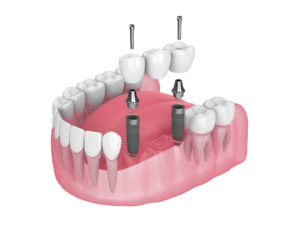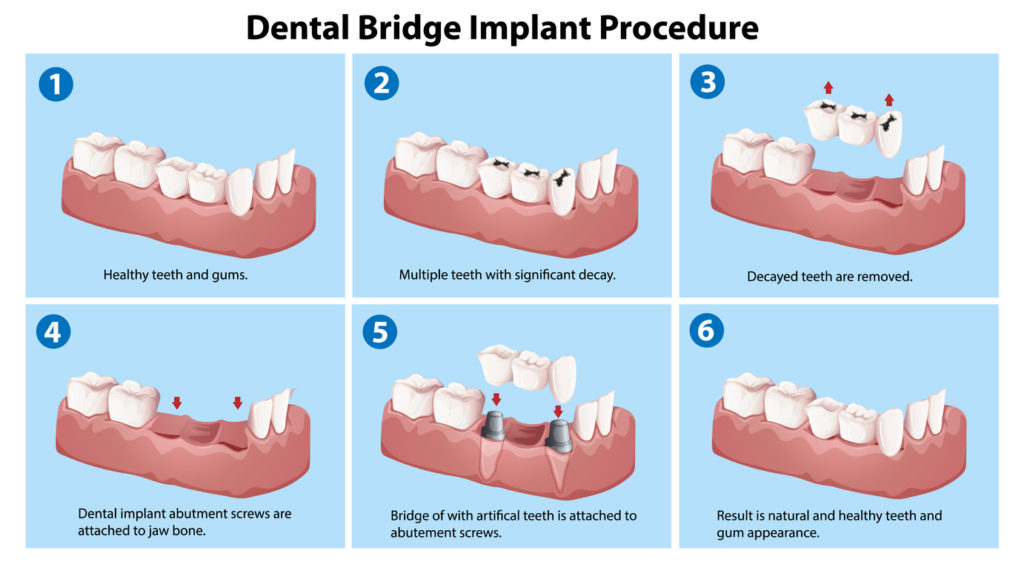
Implant Bridge
Implant bridge is a permanent prosthesis that is supported and built over dental implant rather natural tooth.When a patient lose multiple teeth next to each other fix or permanent solutions are available. Partial dentures are example of removable solutions. Bridges on the other hand are permanent solution which can be placed on nature teeth next to edentulous area or placed on dental implants.
Implant Bridge V.S Partial Denture
Partial dentures and implant bridges are two common solutions for replacing missing teeth. Partial dentures are removable prosthetic devices that attach to the remaining natural teeth, using clasps or attachments to hold them in place. They are cost-effective and non-invasive option for replacing missing teeth. Disadvantage is that they may be less stable and comfortable compared to implant bridges and require regular removal for cleaning. Implant bridges are a more permanent solution that involves surgically placed dental implants to support a fixed bridge. This option offers superior stability, aesthetics, and chewing function, closely mimicking natural teeth. However, implant bridges are typically more expensive and require a surgical procedure. The choice between partial dentures and implant bridges depends on individual factors such as budget, oral health, and personal preferences, and should be made in consultation with a dentist or prosthodontist to determine the most suitable treatment for each patient’s unique needs.
Process
The process for placing an implant bridge involves several stages and typically requires multiple appointments over several months. Here are the key steps involved in the placement of an implant bridge:

Initial Consultation:
Initial consultation with a dentist to evaluate oral health and discuss your treatment options. At this phase suitability for implant-supported bridges is determined based on factors like bone density, overall health, and the number of missing teeth.
Treatment Planning:
If the candidate is suitable for implant bridges, a comprehensive treatment plan will be developed. This plan includes determining the number of dental implants needed, their precise placement locations, and the design of the bridge
Dental Implant Placement:
In the first surgical procedure, dental implants are surgically placed into the jawbone at the predetermined locations. The number of implants depends on the size of the bridge and the strength needed to support it. After implant placement, a healing period of several months is required to allow for osseointegration, which is the process where the implants fuse with the surrounding jawbone.
Abutment Placement:
Once osseointegration is complete, a second minor surgery may be needed to expose the tops of the dental implants. During this procedure an abutments (small connectors) are attached to the implants.
Impressions and Bridge Fabrication:
After the abutments are in place, impressions of your mouth are taken to create a custom bridge that will fit perfectly in your mouth and match the appearance of your natural teeth. This is typically done at a dental laboratory.
Bridge Attachment:
Once the bridge is fabricated, it is attached to the abutments on the dental implants. This step involves securing the bridge in place permanently.
The entire process of placing an implant bridge can take several months, primarily due to the time required for osseointegration to occur. The exact timeline may vary depending on individual factors and any complications that may arise during treatment. At pulse dental we utilize cutting edge technologies along with our clinician skills to get the optimum result with your treatment. Call us today for your free consultation if you are looking for permanent solution for your missing teeth.
FAQ
When choosing between a dental bridge and an implant, it’s important to consider factors like oral health, cost, longevity, and the condition of adjacent teeth. Dental implants are widely considered a more durable and long-term solution. They replace the entire tooth, including the root, which helps preserve the jawbone and maintain facial structure. Implants don’t require altering adjacent healthy teeth, as bridges do. However, implants are typically more expensive and involve a longer, more invasive procedure. Dental bridges, on the other hand, are a quicker, more cost-effective option and are less invasive. They are a good choice when the adjacent teeth are already in need of crowns or have significant fillings. Ultimately, the best choice depends on individual circumstances, and a dental professional should be consulted for personalized advice.
Yes, typically a dental bridge is more cost-effective than an implant. Bridges generally require fewer visits to the dentist and involve a less complex procedure, leading to lower initial costs. While implants are more expensive upfront, they are often seen as a long-term investment in oral health, potentially lasting a lifetime with proper care. In contrast, bridges may need replacement or repair after 5-15 years.
Yes, a dental bridge can be attached to implants. This approach combines the two techniques, using dental implants as the support structure for the bridge rather than natural teeth. This method is often used when several adjacent teeth are missing, and the implants provide a stable foundation for the bridge. It’s particularly beneficial in cases where the adjacent natural teeth are not strong enough to support a bridge or when preserving the integrity of these teeth is a priority.

